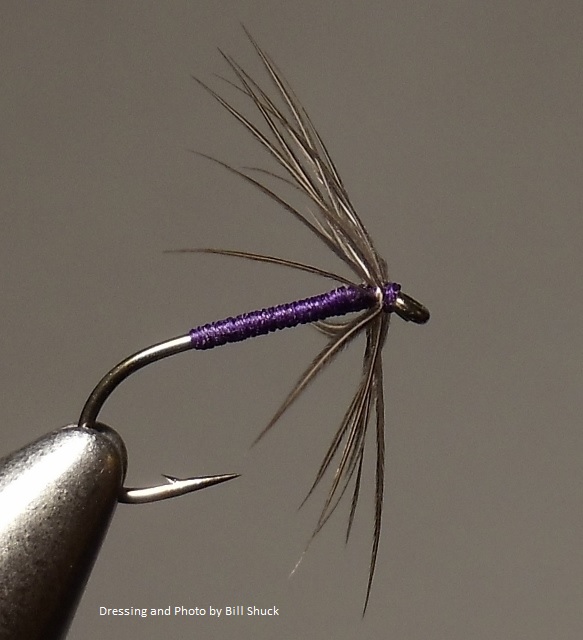Page 1 of 3
Waterhen and Purple
Posted: Thu Nov 21, 2013 12:03 pm
by tie2fish
In the interests of tradition, here is a pattern tied in the North Country style ...

Re: Waterhen and Purple
Posted: Thu Nov 21, 2013 12:08 pm
by Kelly L.
Ah, a spider. I love the North Country spiders.

I love the purple and anything. Did you wax the purple silk? I have read some people don't wax the purple. I have tried it both ways. This is a lovely little fly Bill. A fly after my own heart.
Re: Waterhen and Purple
Posted: Thu Nov 21, 2013 12:46 pm
by Mataura mayfly
Hook size Bill?
I like the way the body stops more bias to the point than the barb and the fact you have the Waterhen well in control.
Owing to a general lack of Waterhen in these parts, I tie a lot of a similar spider with Starling, I wonder if a Pukeko covert might be closer to the Waterhen......
Re: Waterhen and Purple
Posted: Thu Nov 21, 2013 12:49 pm
by letumgo
As simple as these dressings are (three materials), I still find them facinating. One of the things that drew me to the North Country patterns, was their simplicity. I first looked at them and said, I should easily be able to tye that patterns. My first (many) attempts were not even close to the clean lines of your example. Working with silk (course size) and learning how to tye in the hackle and form a clean head, required lots and lots of practice. This is one of the reasons I've stuck with wingless wet flies so long. The challenge of learning the tying techniques, make them interesting (and still does).
Then there was the challenge of getting the materials (Pearsalls silk and waterhen were not carried by my local shops).
Elegant dressing, Bill. Have you any idea how old this pattern is?
Re: Waterhen and Purple
Posted: Thu Nov 21, 2013 1:00 pm
by tie2fish
Only the end of the silk got waxed, Kelly, to help it stay attached to the hook shank using a minimal number of wraps. I tried to hold down body bulk by flattening (untwisting) the thread on the way back to the point and then re-tightening it before coming forward. Jeff, the hook is a Size #14 more-or-less standard wet fly hook with a slight sproat bend. The hackle was tied in by the tip.
Ray, I do not even know if this actually is an historic pattern. I looked through my meager collection of books and did not find one called "Waterhen and Purple", which is why I referred to it as being tied in the North Country style. I would be very surprised, however, if one of those early sportsmen did not use this combination.
Re: Waterhen and Purple
Posted: Thu Nov 21, 2013 2:57 pm
by Izaak
Very nice, Bill! I think you are our first graduate of "heavy hacklers anonymous"!

Lovely feather. Where did you get the waterhen?
Tom
Re: Waterhen and Purple
Posted: Thu Nov 21, 2013 3:28 pm
by gingerdun
That would have been a nice fly, Bill, were it not for that unsightly hump in the top of the body near the hackle.

Seriously, well done. Funny that all these skinny flies are buzzing around the forum just as the weight-gain of the holiday season approaches.
Are you giving us a hint?
Valley Quail hackles also have that stylish white center stripe. My Dad used that feather a lot.
Re: Waterhen and Purple
Posted: Thu Nov 21, 2013 4:47 pm
by Old Hat
That hackle is perfect to me. A fine example of sparseness but not too sparse or overhackled.
Yes the quail is a nice substitute. It is a little more rigid than the waterhen. It behaves a bit like wrapped pheasant hackle. Not as fluid as the water birds. But I don't think underwater it would matter much.
Re: Waterhen and Purple
Posted: Fri Nov 22, 2013 4:31 am
by Ruard
Nice fly and well done.
I did search the fly you tied with the waterhen hackle and purple body but I could only find the Snipe and purple. If you could not find snipe then you could turn the hackle from the neck of a starling. This is the number 10 of the list of Pritt.
Greeting
Re: Waterhen and Purple
Posted: Fri Nov 22, 2013 8:57 am
by William Anderson
gingerdun wrote:That would have been a nice fly, Bill, were it not for that unsightly hump in the top of the body near the hackle.

I just thought that was a wing case. Entomologically suggestive for many of the paralept species.

Beautiful combo, Bill.
w



